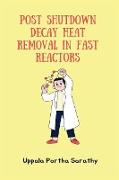- Start
- POST SHUTDOWN DECAY HEAT REMOVAL IN FAST REACTORS
POST SHUTDOWN DECAY HEAT REMOVAL IN FAST REACTORS
Angebote / Angebote:
In a nuclear reactor, most of the nuclear fission energy appears as heat, which is
generally utilized to produce steam for the generation of electricity. The final step is
similar to that used in fossil-fueled power plant. Coming to the basics of nuclear
energy, the mass of a nucleus is always less than the mass of the constituent nucleons.
The difference is known as mass defect. The energy equivalent of the mass defect is
called the binding energy of the nucleus. This is the energy required to break apart the
nucleus into its constituent nucleons. The theory of relativity explains the relation
between the mass defect and the binding energy as E = m ¿ 931.3 where E is in MeV
and m is the mass in atomic mass units. The binding energy per nucleon is relatively
low for nuclei of small mass number but increases, with increasing mass number to a
broad maximum at about 8 MeV in the mass region of roughly 50 to 75, subsequently
the binding energy per nucleon decreases steadily. The nucleus of lower binding
energy per nucleon is less stable and is converted into others of higher binding
energy, i.e., more stable accompanied by a release of energy. Hence, the energy can
be obtained by combination (or fusion) of the light nuclei or by splitting (or fission) of
heavy nuclei.
Folgt in ca. 10 Arbeitstagen




